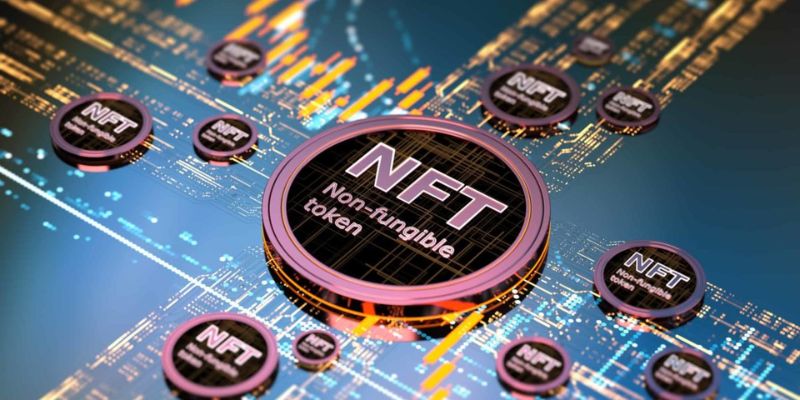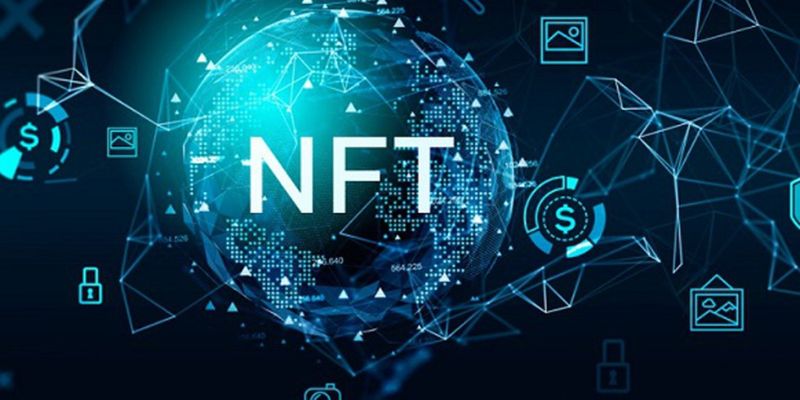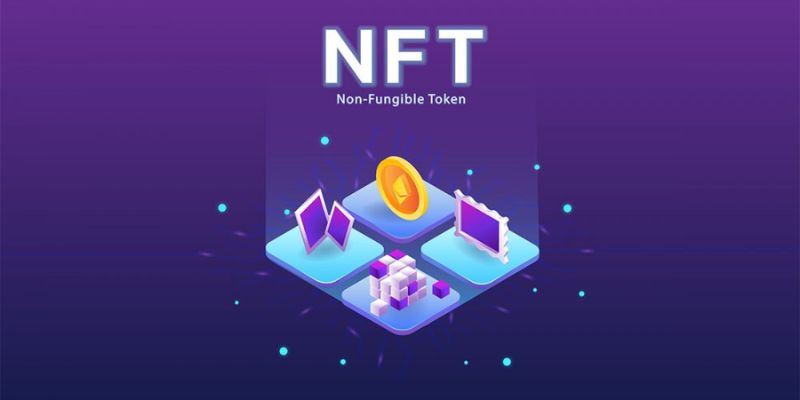Ever find yourself wondering, What is a non-fungible token (NFT)? You’re not alone! These digital assets have taken the world by storm, yet leave many scratching their heads. I’m here to break it down for you. NFTs aren’t just fancy jargon; they’re unique tokens that prove ownership of one-of-a-kind items, from digital art to virtual real estate. Unlike the dollars in your pocket, each NFT is different – think of them like snowflakes with value. They live on blockchain technology, making them as secure as Fort Knox. Stick with me, and you’ll go from puzzled to expert on how NFTs work, how to get your hands on them, and why they might just be the future of digital ownership and beyond. Let’s dive in!
What is a non-fungible token (NFT)? Understanding the Basics of NFTs
Defining Non-Fungible Tokens
Let’s dive right into what NFTs are. An NFT is a one-of-a-kind digital item. It’s unique, like a one-off baseball card, and you can own it. NFT stands for non-fungible token. Unlike regular money, where each unit is the same, every NFT is different. You can buy, sell, and trade these digital assets, and they’re often tied to art, videos, and other online goodies. People like them because they offer a way to prove who owns what, digitally.
NFTs came to fame with artworks selling for millions. But they’re not all about art. They can be anything digital. Think songs, tweets, or virtual outfits in video games. Their worth comes from how rare they are, plus whatever someone’s willing to pay.
The Role of Blockchain Technology in NFT Authenticity
So how do we know an NFT is the real deal? That’s where blockchain comes in. It’s a tech that records information so it can’t be fiddled with. When you get an NFT, blockchain keeps track, like an unbreakable seal of truth. Every time it changes hands, that’s on record. It can be on different blockchains, but Ethereum is where most NFT action happens.
Imagine blockchain as an enormous digital ledger. It’s public, so everyone can see it. That makes cheating tough. Smart contracts, which are self-running computer programs on the blockchain, handle the rules of buying and selling NFTs. They make sure when you buy an NFT, the handover is smooth and follows the rules. This is what makes NFTs reliable and has people excited.
The terms to know here are ERC-721 and ERC-1155. They are like the rulebooks for NFTs on the Ethereum blockchain. ERC-721 was the first, making it possible to track unique digital items. ERC-1155 came next, letting folks create and manage multiple NFTs in one go.
In the NFT world, “minting” is when you create an NFT. It’s like striking a coin, but digital. When you mint an NFT, you’re saying, “This is mine, and here’s the proof.” That’s your cue to sell, trade, or keep it.
NFT marketplaces are the online spots where you can buy and sell NFTs. It’s like eBay, but for digital treasures. And let’s not forget about rights. Owning an NFT means you’ve got the rights to that specific digital asset. Nobody else has it, just you. It’s that scarcity that can make NFTs valuable.
Whether you’re making them or just collecting, NFTs open up lots of possibilities. They change how we think about owning and enjoying digital stuff. From virtual pets like CryptoKitties to digital slices of virtual worlds, these tokens are reshaping our digital lives. It might sound a bit sci-fi now, but NFTs are already planting flags in the digital universe. They’re not just a trend, they’re the new way we’re starting to own and share our digital finds.
The Technical Foundations of NFTs
How Smart Contracts Power NFTs
Imagine you want to buy a special digital card. You pay online and get a unique card nobody else has. This is thanks to smart contracts on the Ethereum blockchain. Smart contracts are like vending machines. You put in a coin, the machine checks if it’s real, and then gives you your snack. But instead of snacks, they make sure you get your digital card, or NFT, without any mix-ups.
Smart contracts run without folks having to check on them all the time. They see when you have paid, and then they give you ownership of your unique item. This is how you truly own the NFT. Each NFT has a special code stored on the blockchain, making it yours alone. So smart contracts help us trade digital items safely, like trading cards in the playground, but all online.
ERC-721 and ERC-1155: Exploring the Token Standards
When we talk about special codes for NFTs, we mean token standards like ERC-721 and ERC-1155. These are rules that say how NFTs should work on the Ethereum blockchain. ERC-721 was the first. It’s like saying, “Every digital card should have its own number to tell it apart.” So if you have a digital card number 123, no one else can have the same.
ERC-1155 is a bit different. It lets you have more than one of some items but still have unique ones too. Imagine you have digital cards where some are common, and you have lots, but you also have rare ones that are just yours. It’s like having a deck of cards where some are shiny and special. ERC-1155 can handle both types – the shiny and the regular ones.
These standards make sure when you’re minting NFTs, which means making them, they fit into the NFT world neatly. They’re like the rules of a game that everyone agrees to follow. When you buy or sell an NFT, these token standards help everyone know what’s what. It makes trading fair and fun.
Nowadays, we’ve got tons of places, or NFT marketplaces, where you can find all sorts of digital stuff. From artwork to game items, music clips to virtual land, there’s a world of things you can collect and own. And it’s all thanks to the smart contracts and standards like ERC-721 and ERC-1155 on the blockchain that make it possible. These pieces of tech are the big brains behind each NFT purchase, sale, or trade, helping us keep track of our digital treasures. They’re helping artists, gamers, and collectors enjoy digital stuff in a whole new way.
Acquiring and Trading Non-fungible Tokens
A Guide to Buying Digital Collectibles
You’ve heard the buzz about NFTs, right? They’re like digital trading cards or unique art pieces. But how do you get your hands on one? First, you need some cryptocurrency, usually Ether, since most NFTs are on the Ethereum blockchain. Think of it like the money you need at an arcade.
Next, you find an NFT marketplace. These are like online malls for digital stuff. Places like OpenSea or Rarible are where the action happens. You set up an account, load it with your Ether, and start shopping.
Now let’s say you spot a piece of crypto art you love. You can buy it outright if there’s a price tag, or you might have to bid in an auction, just like at a real-life art sale. Win the bid, and voila! You’re the proud owner of an NFT.
Here’s where it gets cool. Each NFT has a smart contract attached. These contracts are like the rules of a game, written in stone. They make sure that the digital collectible you’re buying is the real deal—it can’t be copied or messed with. When you buy an NFT, your ownership is recorded on the blockchain. It’s as if someone wrote your name on the art, but in a way that can’t be erased or covered up.
Insights into
Non-Fungible Token Marketplaces and Trading Practices
NFT trading is more than just click and buy. It’s about knowing when to hold ’em and when to fold ’em. Some people buy NFTs to keep, like collecting stamps or rare action figures. Others flip them for profit, buying low and selling high.
Knowing the market can make all the difference. NFT prices can swing wildly. This is where doing your homework helps. You can track how much similar NFTs are selling for and get a sense for what’s hot or not.
Selling is the flip side of the coin. Maybe you made digital art, or you have a cool NFT you’re ready to part with. You can list it for sale on the marketplace, set your price, or let people bid. Just remember, if someone buys it, you pay a fee to the marketplace, kind of like commission to an art dealer.
NFTs are more than art, though. There’s a whole world of virtual goods out there. You could buy digital real estate in a virtual world, or grab a collectible from a game like CryptoKitties. These aren’t just pictures; they can be part of huge online spaces and communities.
In the end, whether you’re buying or selling, it’s about having a good time and maybe finding something that means something special to you. Who knows? That digital collectible might just be the next big thing. And you could say you were there when it all started.
Beyond Ownership: The Utility and Future of Non-Fungible Token
Intellectual Property and NFT Ownership Rights
When you buy an NFT, you get more than a digital picture. You hold something no one else does. It’s like owning a one-of-a-kind baseball card but in the digital world. People can copy the image, but they can’t copy the NFT’s unique properties. This “token” lives on the blockchain. That’s a digital book that keeps every change, making your NFT safe and sound.
Why is this important? Think about artists. They make a cool drawing and turn it into an NFT. When they sell it, they know it won’t just get copied and shared for free. The blockchain’s smart contracts can even make sure they get a cut of the money if their artwork is sold again.
NFTs are different from normal things you buy. They’re one-of-a-kind. You can prove you own the original. Just like you show a card to prove you own your online game character. Now, with NFTs, we can do that for art, videos, and even tweets!
Let’s talk about something really cool — utility NFTs. These are not just for show. They give you special powers, like a ticket to an event or new moves in a game. You can even own virtual land with them. That’s right, you can have a piece of a new world inside a computer. You can build a house or start a shop there. It’s like a video game, but some folks make real money from it.
Gaming NFTs are changing how we play too. In the past, if you bought a sword in a game, it stayed in that game. Now with NFTs, you can trade it or sell it. You might even take it to another game. This gives your digital stuff real value, just like if you sold an old toy or game.
You might hear about ERC-721 and ERC-1155. These are rules that say how to make NFTs. They make sure all NFTs speak the same digital language. This way, they can move around the blockchain with no problems.
So, if you’re thinking of getting into NFTs, here’s a little guide. First, pick something you like. It could be anything digital — art, music, games. Then you go to an NFT marketplace. It’s like a digital mall for buying and selling NFTs. You’ll need some cryptocurrency, like Ether, to pay for your NFT. That’s the money for the Ethereum blockchain — the big digital space where many NFTs live.
Remember to think about what the NFT you want could do for you. Will it let you into a virtual concert? Will it make your online character stronger? Or maybe it’ll just be a super cool thing to own. Think of it like collecting stamps with superpowers!
In short, NFTs give us a new way to own things that matter to us. Whether it’s art, a game item, or a new song, NFTs make it special because it’s truly yours. No one else has the token that says, “This one’s mine!” And that’s pretty awesome.
To wrap it up, we dove into NFTs and uncovered their unique nature. We saw how blockchain makes each NFT authentic and hard to fake. We explored smart contracts and learned about special token types, ERC-721 and ERC-1155. Then, I showed you how you can buy and trade these digital items. We even looked at what owning an NFT truly means, including rights and gaming fun.
Thinking about the future of NFTs excites me! They’re more than just digital art. They’re a new way to own and use cool stuff online. They could change games and how we think about owning things. So, keep your eyes on NFTs; they’re just getting started. They might just surprise you with what they can do! Follow Dynamic Cryto network to update more knowledge about Crypto.
Q&A :
What Exactly Is a Non-Fungible Token (NFT)?
A Non-Fungible Token (NFT) is a unique, digital token that represents ownership of a specific item or piece of content, usually on the blockchain. Unlike cryptocurrencies such as Bitcoin or Ethereum, which are fungible and can be exchanged on a one-to-one basis, each NFT has a distinct value and cannot be exchanged like-for-like. This distinct characteristic allows artists, musicians, and content creators to monetize their digital works by offering verifiable, exclusive ownership to buyers.
How Do NFTs Function and What Are They Used For?
NFTs function using blockchain technology, mainly on the Ethereum network, though other blockchains support them as well. They are used for a variety of purposes such as buying and selling digital art, collectibles, gaming items, and more. Because they are built on blockchain technology, NFTs are resistant to fraud and provide a transparent record of ownership history. This helps ensure authenticity and can prevent duplication of digital items.
Why Are non-fungible tokens Considered Valuable?
The value of an NFT comes from its scarcity and the demand for the unique digital asset it represents. They’re considered valuable because they offer a way to prove ownership of a digital item, which otherwise could be easily copied without any loss in quality. NFTs have gained significant traction as a way for creators to gain recognition and revenue for their digital works, with some selling for millions of dollars.
Can Anyone Create an NFT, and How Would One Do This?
Yes, anyone can create an NFT. The process involves creating or digitizing your content, whether it’s art, music, or any other form of creative work. Then, you must choose a blockchain and a platform that supports NFT creation (known as “minting”). After setting up a digital wallet and possibly purchasing some cryptocurrency, you can use an NFT marketplace to mint your NFT, which is then ready for sale or trading.
Are There Risks Associated With Buying NFTs?
Like any investment, buying NFTs does have risks. These can include market volatility, where the value of an NFT can fluctuate wildly, leading to potential losses. There’s also the risk of fraud or buying counterfeit NFTs if one does not perform due diligence on the sellers and platforms. Moreover, as the technology is relatively new, regulatory changes could affect the NFT marketplace and the value of NFTs in the future. Buyers should always conduct thorough research before making any purchases.



